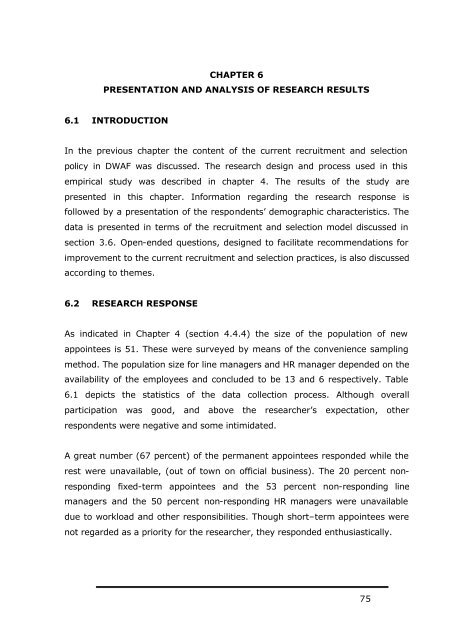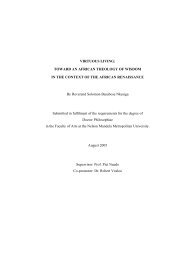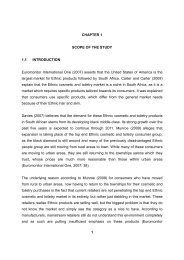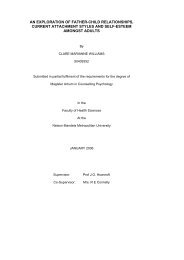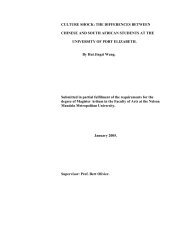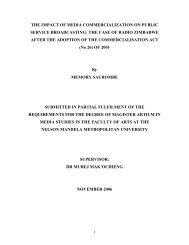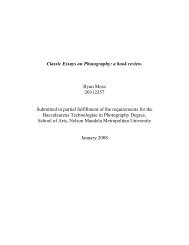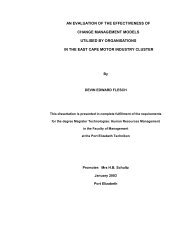an evaluation of the recruitment and selection policy and practice in ...
an evaluation of the recruitment and selection policy and practice in ...
an evaluation of the recruitment and selection policy and practice in ...
Create successful ePaper yourself
Turn your PDF publications into a flip-book with our unique Google optimized e-Paper software.
CHAPTER 6PRESENTATION AND ANALYSIS OF RESEARCH RESULTS6.1 INTRODUCTIONIn <strong>the</strong> previous chapter <strong>the</strong> content <strong>of</strong> <strong>the</strong> current <strong>recruitment</strong> <strong>an</strong>d <strong>selection</strong><strong>policy</strong> <strong>in</strong> DWAF was discussed. The research design <strong>an</strong>d process used <strong>in</strong> thisempirical study was described <strong>in</strong> chapter 4. The results <strong>of</strong> <strong>the</strong> study arepresented <strong>in</strong> this chapter. Information regard<strong>in</strong>g <strong>the</strong> research response isfollowed by a presentation <strong>of</strong> <strong>the</strong> respondents’ demographic characteristics. Thedata is presented <strong>in</strong> terms <strong>of</strong> <strong>the</strong> <strong>recruitment</strong> <strong>an</strong>d <strong>selection</strong> model discussed <strong>in</strong>section 3.6. Open-ended questions, designed to facilitate recommendations forimprovement to <strong>the</strong> current <strong>recruitment</strong> <strong>an</strong>d <strong>selection</strong> <strong>practice</strong>s, is also discussedaccord<strong>in</strong>g to <strong>the</strong>mes.6.2 RESEARCH RESPONSEAs <strong>in</strong>dicated <strong>in</strong> Chapter 4 (section 4.4.4) <strong>the</strong> size <strong>of</strong> <strong>the</strong> population <strong>of</strong> newappo<strong>in</strong>tees is 51. These were surveyed by me<strong>an</strong>s <strong>of</strong> <strong>the</strong> convenience sampl<strong>in</strong>gmethod. The population size for l<strong>in</strong>e m<strong>an</strong>agers <strong>an</strong>d HR m<strong>an</strong>ager depended on <strong>the</strong>availability <strong>of</strong> <strong>the</strong> employees <strong>an</strong>d concluded to be 13 <strong>an</strong>d 6 respectively. Table6.1 depicts <strong>the</strong> statistics <strong>of</strong> <strong>the</strong> data collection process. Although overallparticipation was good, <strong>an</strong>d above <strong>the</strong> researcher’s expectation, o<strong>the</strong>rrespondents were negative <strong>an</strong>d some <strong>in</strong>timidated.A great number (67 percent) <strong>of</strong> <strong>the</strong> perm<strong>an</strong>ent appo<strong>in</strong>tees responded while <strong>the</strong>rest were unavailable, (out <strong>of</strong> town on <strong>of</strong>ficial bus<strong>in</strong>ess). The 20 percent nonrespond<strong>in</strong>gfixed-term appo<strong>in</strong>tees <strong>an</strong>d <strong>the</strong> 53 percent non-respond<strong>in</strong>g l<strong>in</strong>em<strong>an</strong>agers <strong>an</strong>d <strong>the</strong> 50 percent non-respond<strong>in</strong>g HR m<strong>an</strong>agers were unavailabledue to workload <strong>an</strong>d o<strong>the</strong>r responsibilities. Though short–term appo<strong>in</strong>tees werenot regarded as a priority for <strong>the</strong> researcher, <strong>the</strong>y responded enthusiastically.75


